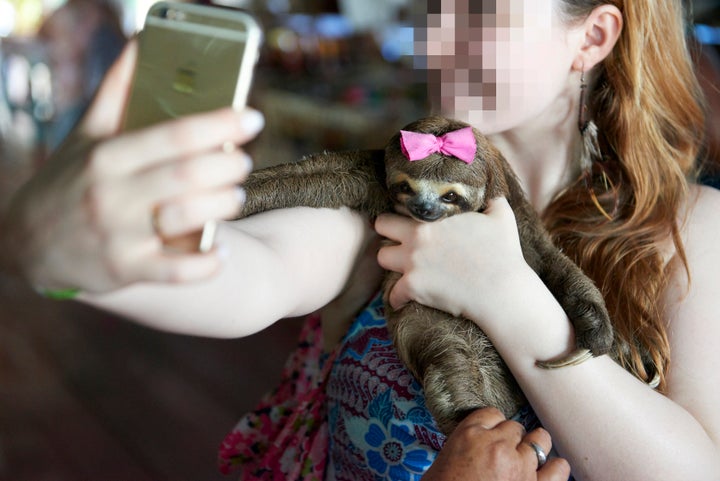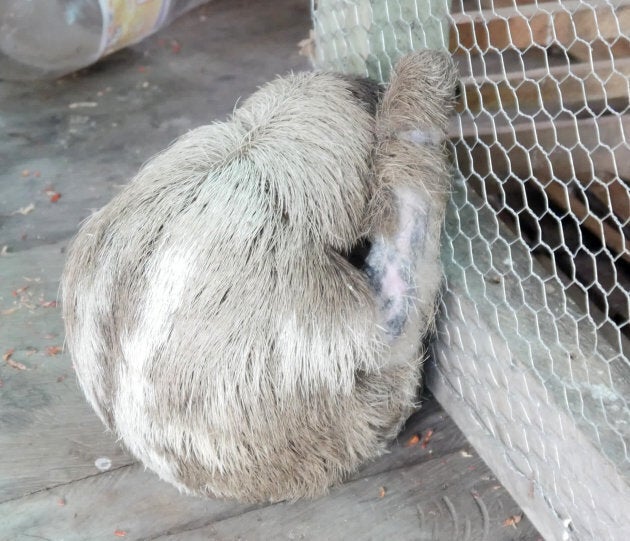Have you ever been presented with the opportunity to cuddle a tiger cub or baby sloth? Who wouldn't want a photo with these adorable animals? Well I'm urging you to resist the next temptation because there is a lifetime of cruelty behind that seemingly picture-perfect moment.

A new investigation by World Animal Protection uncovered the alarming trend of wildlife selfies and the cruelty that happens behind the scenes. The rise in mobile phones and social media has resulted in a serious animal welfare and conservation problem. And it is happening all around the world, even far deep in the Amazon rainforest, a place where you would think wildlife are most protected.
In the heart of the Amazon jungle, wild animals such as sloths, dolphins, snakes and monkeys are being plucked from their habitat — often illegally — to be handed over to tourists for selfies. Our investigators found baby sloths that had been snatched from their mothers to be kept as a tourist lure and photo prop. The mothers are often killed in the process and when the tourists have gone home, the baby sloths are kept in small, barren cages. They found caimans kept in broken refrigerators with their jaws restrained by rubber bands to try to make selfies safer for tourists. But it is far from safe for the animals involved. Some animals were beaten into submission while others showed physical scars from rough handling.
Many of these animals won't be released back into the wild and their chances of survival are slim if they are. Sloths won't likely survive more than six months when used for selfie tourism. Their low metabolism, slow movement and restricted diet make them particularly difficult to keep humanely in captivity and rehabilitate for release back into the wild.

The well-intentioned eco-tourist is not likely aware of the suffering they are causing before they snap their photo. Unfortunately for sloths, they look like they are smiling even when they are suffering and they're slow to react to stress and pain stimuli. But make no mistake, they're scared when handled by tourists all day and suffer when denied every opportunity to behave naturally. In the wild, they spend the majority of their lives in the tree canopy but our investigators found sloths living on the ground, tied to trees.

Here in Canada, many zoos offer visitors the opportunity to hold a wild animal for a selfie and will lend their animals out for photo props at events as Justin Bieber famously highlighted when he posed with a lion cub and a tiger at a party in Toronto in the spring of 2016. An undercover video released by Animal Justice last August shows the appalling cruel treatment of animals at a zoo near Ottawa which allows people to take wildlife selfies.
Thankfully, Toronto just voted to ban mobile zoos from bringing exotic animals like kangaroos and large snakes to events in the city but many types of wild animals are still permitted at birthday parties and community events in the city and across the country. Whether the animal is a turtle, stingray, snake or lion cub, handling wildlife comes at a high cost to the animal's welfare and sends the public the wrong message — a message that runs contrary to the one our park rangers and wildlife conservation officers are trying to spread.
Parks Canada staff say an increasing number of tourists are getting dangerously close to bears and other wild animals all for the sake of a photo. People have been maimed taking selfies with bison in Yellowstone National Park. People around the world were outraged upon learning that three dolphins died for selfies in separate incidents over the course of 18 months after being plucked out of the ocean and passed around a beach in Argentina and Spain. When will this nonsense stop before more people and animals are harmed?
It starts with all of us. If you can hug or hold a wild animal, it is cruel, so please don't do it. By not engaging in wildlife selfies, you will help end the profitability of this industry and keep wild animals where they belong: in the wild. Now of course if an animal photobombs you, go ahead and promote your picture! If the animal is domesticated, chooses to be in your picture and has every opportunity to behave naturally, it's likely a humane photo. The best way to experience wildlife is in the wild and from a respectful distance. For tips on how to protect animals while travelling and to take World Animal Protection's Wildlife Selfie Code, please visit www.worldanimalprotection.ca
Also on HuffPost: